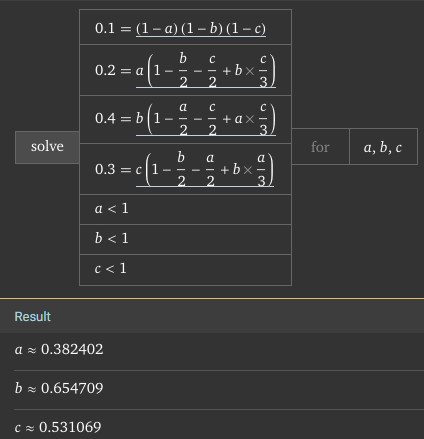This is true, but with a good frontend users don’t even need to think about this. Because with the current price of the tokens, we can infer the probability of all events if we assume them to be independent.
I’ll show the case where n=3, with probabilities of events A, B, C being respectively a, b and c. We’ll call t the number of events ending up happening.
- The price of Y (“No to all”): y=(1-a)(1-b)(1-c)
- Price of A YES: x_A=a(1 - \frac{1}{2}p(t=2|A) -\frac{2}{3}p(t=3|A)) = a (1-\frac{b}{2}-\frac{c}{2}+\frac{b c}{2})
- Price of B YES: x_B= b (1-\frac{a}{2}-\frac{c}{2}+\frac{a c}{2})
- Price of C YES: x_C= c (1-\frac{b}{2}-\frac{a}{2}+\frac{b a}{2})
So we have a system of 4 equations with 3 unknowns. I don’t think that there is a closed form equation for it, but a solver should be able to handle it.
I tried on Wolfram alpha with y=0.1,x_A=0.2,x_B=0.4,x_C=0.3 and got the result.
Now, the frontend to make those kind of predictions would work the following way:
- Compute the current event probabilities and display those to users.
- User picks an event he wants to predict on.
- User specifies his predicted probability of the event.
- Compute the price of the related token, but this time replacing the probability of the event in question by the user input.
- Place an order to buy/sell the related token depending of the computed price.
Continuing with the current example, the front would display:
a: 0.382
b: 0.654
c: 0.531
y: 0.100
The user wants to predict that a is 0.5, we express it by a'=0.5.
So we compute x_A'= a' (1-\frac{b}{2}-\frac{c}{2}+\frac{b c}{2}) = 0.262.
So the frontend proposes to buy tokens of the event A up to a maximum price of 0.262.
The drawback is that there would be some randomness in the user payout (I mean from their perspective, as they’d get an exposure to events they are not knowledgeable about). But if the market is pretty big, the relative variance in term of the number of events happening would be lowered (so the market would actually be less random the larger it is).
I wonder if we could have a prediction market based on this principle. I would see this a bit like the “GMX of prediction markets”.
